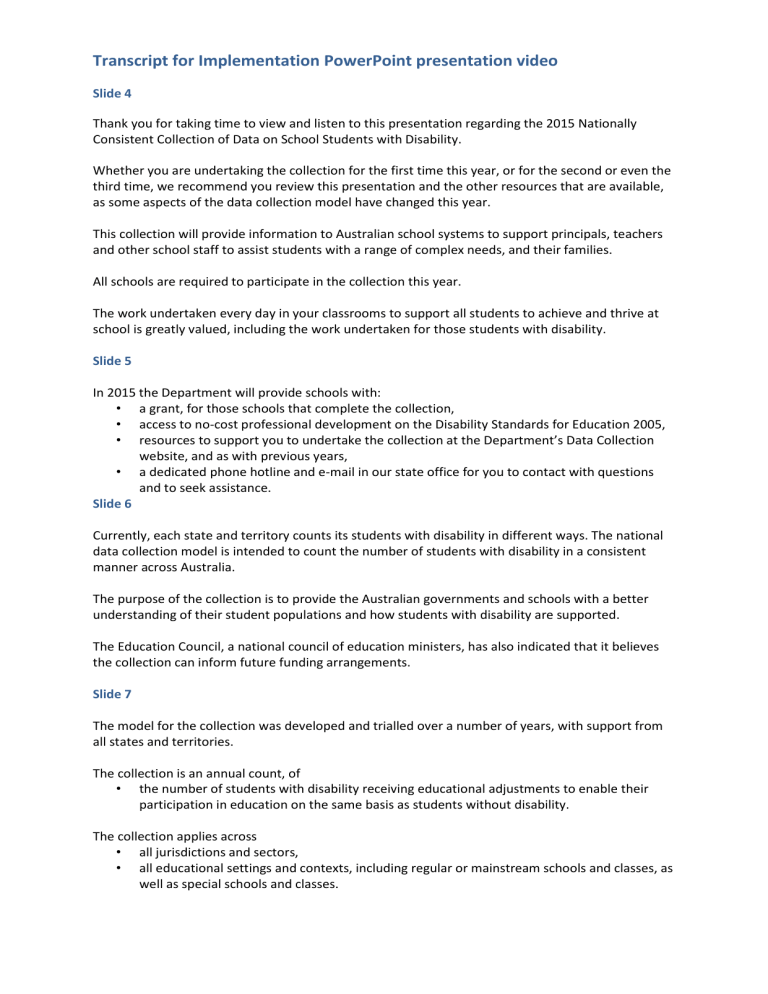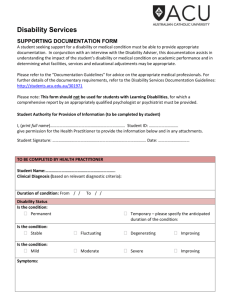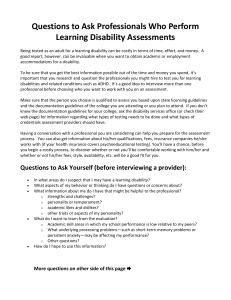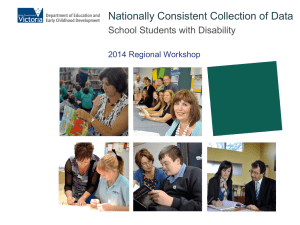NCCD Implementation powerpoint transcript

Transcript for Implementation PowerPoint presentation video
Slide 4
Thank you for taking time to view and listen to this presentation regarding the 2015 Nationally
Consistent Collection of Data on School Students with Disability.
Whether you are undertaking the collection for the first time this year, or for the second or even the third time, we recommend you review this presentation and the other resources that are available, as some aspects of the data collection model have changed this year.
This collection will provide information to Australian school systems to support principals, teachers and other school staff to assist students with a range of complex needs, and their families.
All schools are required to participate in the collection this year.
The work undertaken every day in your classrooms to support all students to achieve and thrive at school is greatly valued, including the work undertaken for those students with disability.
Slide 5
In 2015 the Department will provide schools with:
• a grant, for those schools that complete the collection,
• access to no-cost professional development on the Disability Standards for Education 2005,
• resources to support you to undertake the collection at the Department’s Data Collection website, and as with previous years,
• a dedicated phone hotline and e-mail in our state office for you to contact with questions and to seek assistance.
Slide 6
Currently, each state and territory counts its students with disability in different ways. The national data collection model is intended to count the number of students with disability in a consistent manner across Australia.
The purpose of the collection is to provide the Australian governments and schools with a better understanding of their student populations and how students with disability are supported.
The Education Council, a national council of education ministers, has also indicated that it believes the collection can inform future funding arrangements.
Slide 7
The model for the collection was developed and trialled over a number of years, with support from all states and territories.
The collection is an annual count, of
• the number of students with disability receiving educational adjustments to enable their participation in education on the same basis as students without disability.
The collection applies across
• all jurisdictions and sectors,
• all educational settings and contexts, including regular or mainstream schools and classes, as well as special schools and classes.
Slide 8
Under the Disability Discrimination Act 1992 (or the DDA), and the Disability Standards for Education
2005 (the DSE), all Australian schools have obligations towards students with disability.
The DDA and DSE underpin the methodology of the data collection Model.
The collection reinforces the existing obligations that schools have towards students under the DDA and the DSE, and counts the students who are supported under these obligations based on the professional judgement of our teachers, and their understanding and knowledge of their students.
Slide 9
The broad definition of disability as described in the Act includes:
• total or partial loss of a person's bodily or mental functions
• total or partial loss of part of the body
• the presence in the body of organisms causing disease or illness
• the presence in the body of organisms capable of causing disease or illness
• the malfunction, malformation or disfigurement of a part of the person's body
• a disorder or malfunction that results in the person learning differently from a person without the disorder or malfunction
• And finally, a disorder, illness or disease that affects a person's thought processes,
• perception of reality, emotions or judgement or that results in disturbed behaviour.
The Act also covers disabilities that people have now, have had in the past, or may in fact have in the future, or which they’re believed to have by others.
Slide 10
It is not the intention of this collection to count every student who is protected from discrimination under the broad definition in the DDA. Rather the collection relies upon informed teacher judgement, and the understanding and knowledge schools have of their individual students, to decide which students are receiving adjustments to access education because of their disability. This is consistent with a school’s legal obligations under the DDA and DSE.
Slide 12
The Venn diagram clearly illustrates this concept. The students we want to count in the collection are those in the central or overlapping section of the diagram: those students receiving educational adjustments to address a disability as defined by the DDA in order to provide them with access to and participation in their education. As mentioned previously this is consistent with a school’s obligations under the DSE.
Slide 13
If you or your school has undertaken the collection in previous years please note that that a few improvements have been made to the process in 2015.
1.
Previously where there was evidence at the school to demonstrate that adjustments had been in place during the 10 weeks prior to the submission date, and the student or their family had been consulted about these adjustments, the student was eligible to be counted in the collection.
The wording of the model has now changed to read:
“Evidence at the school should demonstrate that adjustments have been in place for a minimum period of one school term, or at least 10 weeks, in the 12 months preceding the collection.”
2.
The category of adjustment – ‘No adjustment at this time’ has been updated and revised to read ‘Students with disability for whom support is provided within quality differentiated teaching practice’.
3.
Targeted ‘opt-out’ consent is now no longer required for each student to be included in the count. Instead schools will provide a notice about the collection to the whole school community.
In 2014, schools were required to inform parents or carers of those students identified for inclusion in the collection about the process, and about their right to opt-out of participation in the collection.
Schools were provided with a template letter which was to be provided to the parents, carers or guardians of those students identified for inclusion in the collection.
In 2015, ‘targeted ‘opt-out’ consent’ is no longer required. On the 11 th of December 2014 the
Australian Education Regulation 2013 was amended to authorise the collection of certain information, by the Australian Government Department of Education and Training, from approved authorities under the Australian Education Act 2013, specifically for the purpose of the Nationally
Consistent Collection of Data on School Students with Disability.
The Department has prepared a ‘Collection Notice’ for your use. The notice explains the information to be collected, why it‘s being collected, and what will happen with it. It provides appropriate wording and content. Digital versions of the notice are also available in 12 languages on the
Departments website.
School Principals can decide how the messages are best communicated to their families and can choose the most appropriate formats for providing this information to their school community.
This might include via:
• the school website
• the weekly school newsletter
• information sheets
• over the telephone or face-to-face conversations
• e-mail or SMS
• Or even personalised written correspondence.
Slide 14
Many schools have taken part in the phased implementation of the collection in the last two years.
Collectively, they‘ve suggested that the following points have assisted them in implementing the collection in their schools:
1.
The principal is responsible for ensuring the implementation of the collection in the school, however a strong, strategic and effective school leadership and executive team that is actively engaged, will strengthen the implementation process, support planning, reporting and compliance.
2.
The school leadership, executive team and the team directly involved in implementing the collection, must complete the relevant professional learning and training.
3.
As stated previously, the collection relies on the professional judgements of teachers about their students, and requires them to make evidence-based decisions about adjustments, consistent with obligations under the DSE.
4.
A whole school or school team approach, connecting teachers and support staff to the collection and its processes, will strengthen the quality of the collection’s data. Over recent years this strategy was used by many schools to moderate decision making. Collaborating with colleagues to discuss experiences and opinions can provide assurance within a school, within multiple campuses, or even within networks of schools, that the interpretations or
Slide 15 applications of the collection model don’t differ significantly.
The model for the collection consists of four steps.
Underpinning these four steps is evidence that currently exists within the school, evidence of the actions that teachers and school staff have taken as part of their day to day teaching practice.
This evidence includes:
• the assessed, identified educational needs of a student with a disability,
• And the provision of personalised adjustments to meet the student's identified needs when
• these are provided in consultation with the student and/or their parents and carers.
School principals will verify or confirm that there is evidence at their school to support the inclusion of a student in the data collection.
Slide 16
A key step in identifying whether a student at your school is eligible to be included in the collection, is determining whether they‘re being provided with a reasonable adjustment to access and participate in education because of disability, consistent with definitions and obligations under the DDA and DSE.
Slide 17
Quality teaching practice is responsive to the differential needs of all students. Some students with disability may not need educational adjustments beyond those that are reasonably expected as part of quality teaching or school practices that address disability related needs.
Reasonable adjustments can be made across any or all of the following:
• teaching and learning
• assessment
• reporting
• extra-curricular activities
• Or environment and infrastructure.
Slide 18
The Disability Standards for Education state, that before the school makes an adjustment for a student, the education provider must consult the student, or the family or carer of the student, in order to determine the type of adjustment required.
Slide 19
We referred earlier to the evidence required to support a student’s inclusion in the count. This evidence will determine which students are to be included in the collection, and will also be used to inform your decisions regarding the levels of adjustment for each student, which is step 2 of the data collection model.
Slide 21
Previously, schools had been asked to use their professional judgement to determine the level of adjustment that applied to each student included in the collection. They used the following four levels:
• No adjustment at this time
• Supplementary adjustment
• Substantial adjustment
• And Extensive adjustment
Please note, that the first level - ‘No adjustment at this time’ – has now been changed to:
‘Students with disability for whom support is provided within quality differentiated teaching practice’.
Students identified in this category do not require the sorts of adjustments that are captured in the other three levels. However, their teachers are conscious of the need for explicit, albeit minor, adjustments to teaching practice that enable the student to access learning on the same basis as their peers. This category would include general adjustments that have been made in a school as part of developing or maintaining a culture of inclusion.
Examples for this category could include:
• a differentiated approach to curriculum delivery and assessment that anticipates and responds to students’ learning differences
• personalised learning that is implemented without drawing on additional resources
• a student with a health condition or a mental health condition, that has a functional impact on their schooling, and requires ongoing monitoring, but does not require a higher level of support or adjustment during the period they're being considered for the collection
• Or even a whole school professional learning for the management of health conditions such as asthma or diabetes which form part of a school’s general, ongoing practice, to equip teachers and education staff with the skills and knowledge to support students’ health needs.
Slide 22
As well as identifying the level of reasonable adjustment, schools are asked to identify the broad category of disability for each student from one of four categories.
They are:
• Physical
• Cognitive
• Sensory
• And social/emotional.
If a student has multiple disabilities, the school should select whichever category has the greatest impact, based on your professional judgement, on the student’s education, and is the main driver of the adjustments you have in place to support that students access and participation in education.
To guide your decisions, refer to the ’category of disability’ table found on the Department’s data collection website. This outlines the DDA definition of disability, the Australian Human Rights
Commission interpretation and the broad disability categories that are used in this collection.
Slide 23
Before data is submitted to the Department via CASES21, the school principal must verify that there is evidence to support the inclusion of these students in the collection.
Once verified, data must be entered into CASES21 on, or before, Friday the 7 th of August 2015. Each entry takes less than a minute, but can only be undertaken by a staff member with access rights to
CASES21.
Please remember, no student details are collected as part of this collection. The data provided to the
Australian Government Department of Education and Training is provided as aggregated figures.
Slide 26
We hope the content in this presentation provides you with a sound understanding of how to proceed with implementing the data collection.
The department will continue to support schools through the implementation of the collection and remember that Grants will be available for those schools who complete the collection, and a range of other resources are available to support you at our Data Collection website.
Support and assistance is also available through our Department email and phone hotline.








